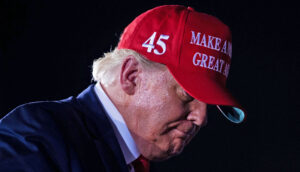Is Donald Trump part werewolf? Perhaps so, according to a remarkable little paper published in 2017, “Donald Trump, Werewolf Spawn?”, by Kevin D. Pittle and Nicholas A. Hopkins. The authors speculate, on the basis of inconclusive but interesting evidence, that Trump may be descended from Peter Stumpf, one of the most famous victims of Europe’s 16th-century werewolf trials.
Connoisseurs of werewolf lore will doubtless remember that Stumpf, also known as Peter Stubbe, was tortured on the rack until he confessed to murder, cannibalism, rape, incest, bestiality, and pretty much every other crime the local inquisitors could think of. He was then broken on the wheel, beheaded, and burnt at the stake in Cologne on 31 October 1589. His daughter and a woman named Katharina Trump, both of whom were accused of having affairs with him, were also burnt at the same time. The latter, Pittle and Hopkins note, may well have been the same Katharina Trump who features in the family tree of Donald Trump. If this is true — and again, this is a speculative hypothesis — Donald Trump is descended from a werewolf’s love child.
By now, those readers who don’t happen to be connoisseurs of werewolf lore may be scratching their heads, so let me explain. Yes, there were werewolf trials in 16th-century Europe — quite a few of them, in fact, and more in the centuries immediately before and after. They were conducted in the same dubious fashion as the witch trials of those same years: that is to say, once an accusation was made, the accused was presumed to be guilty, tortured savagely in order to extract a confession, and then put to death, preferably after he’d implicated several other people who could then be subjected to the same treatment. It was an ugly chapter of history, though there are plenty of equivalents before and since.
Follow the track of the werewolf back into the mists of Eurasian antiquity and it’s possible to trace the outlines of an archaic set of traditions of the Indo-European peoples back when they were cattle-herding tribes on the plains of what are now Ukraine and southern Russia. In those days, boys who reached puberty left their home villages to dwell in the forest under the tutelage of elder shamans. For a period of several years, they spent the summers living like wild things, eating raw meat, sleeping in the open, and raiding neighbouring tribes to steal cattle. The winters, in turn, were devoted to harsh austerities and rituals of initiation.
The most important of those rituals centred on the mythic theme of casting off the participants’ identity as boys and becoming wolves: fierce, predatory, loyal, tough, attuned to the wilderness. Then, once their period in the forest was finished, they cast off their wolf-identity through another ritual process, became men, and returned to their villages to take up their social roles as husbands, fathers, providers, and warriors. For thousands of years, that was how the Indo-European tribes handled the turbulent transition from boyhood to manhood, and mythic echoes of these same customs remained in Indo-European societies from India to Ireland long after the original tradition had faded out.
Did these boys in the wilderness actually turn into wolves? Not in any biological sense, surely. That said, human consciousness is capable of strange things. Certain bands of Norse warriors in historic times were called Úlfhednar, “wolf coat wearers”; like their close equivalents the Berserkir, “bear shirt wearers”, they could enter into a battle-frenzy in which they behaved like wild beasts, possessing superhuman strength, insensibility to pain, and the ability to walk over burning coals unscathed. (A priestly clan among the Faliscans, an Italian people absorbed by the Romans, had the same firewalking reputation; they were called hirpi Sorani, “wolves of the god Soranus”.) Certain kinds of out-of-body experience, in which the participants experience themselves as taking on animal form, also seem to be caught up in the same tradition. It’s a heady mix of practices, more than enough to make its initiates fierce and effective warriors in an age of hand-to-hand combat.
The initiation rituals referenced above aren’t simply a matter of speculation. Archaeologists have dug up at least one site where they were performed: an isolated structure at Krasnosamarskoe in Russia, dating from around 1800BC, where dogs were ceremonially sacrificed and eaten in the midst of other ritual activities. Dogs are considered good eating in many cultures, but in societies descended from the Indo-European tribes, the thought of eating dog meat gets an immediate reaction of repulsion. That’s the last dim echo of an archaic taboo that once restricted eating the flesh of canids to the wolf-boys in the forests. The dog sacrifices took place during the winter ritual season — you can tell such things these days from skeletal remains. Combine that evidence with input from myth, legend, and folk tradition and you can glimpse a little of the ancient wolf-magic as it once existed.
That, to sum up decades of scholarly research, is what lies behind the legendary image of the werewolf in European folklore. After the great Indo-European migrations and conquests, the bands of boys-become-wolves in the forests gradually changed into permanent warbands under the command of local chieftains, and then morphed further into the feudal system of medieval Europe, with each young generation of warriors absorbed into the retinues of barons and kings, and so no longer a threat to the status quo. The old traditions clung to shadowy life here and there, mostly in isolated areas, and gave rise to bands of outlaws: in several old Indo-European languages, as a result, the word for “wolf” is also the word for “outlaw”. (In Old Norse, that word is vargr, which is where Tolkien got the word “warg”.)
As medieval European society settled down after the era of mass migrations, and Christianity became more centralised and dogmatic, surviving traces of the old shamanistic traditions got squeezed out a little at a time. Whether or not Peter Stumpf was involved in one of the last flickering traces of the old wolf-cult will probably never be known, but it is at least possible. It’s also possible that a few scraps of the old tradition still survive, either in Europe or in some corners of the European diaspora.
Whether any remnant of the archaic wolf-cult endured, however, it’s safe to say that its archetype certainly did, and it remains a living and potent force today. Imagine for a moment how the reputation of the ancient wolf-initiates changed as the tribal cultures of Indo-European antiquity gave way to the settled societies of medieval Europe, as warriors were expected to become the loyal servants of feudal magnates and the new ideology of Christianity put its own spin on the legacies of the distant past. Here and there, as in the legends of Robin Hood, outlaws seized the popular imagination as an emblem of resistance to the status quo, but far more often the fierce, lonely men who had been driven out of polite society and dwelt in deep forests and mountainous regions were feared and despised by the respectable people of their time. It was proverbial in medieval England that outlaws “had a wolf’s head” — that is to say, like the wolf that was their ancient emblem, they could be killed out of hand by anyone tough enough for the job, and their deaths would be met with general rejoicing.
This, of course, is where we circle back to Donald Trump. Well before a jury found him liable for sexual abuse this week, the man had made an enduring mark on American culture by violating all the rules that polite society had erected to maintain the grip of today’s privileged classes on the levers of political and social power. It’s a piece of synchronicity that Carl Jung would have appreciated that Trump may be descended from a famous werewolf, because he’s the outlaw of today’s American politics, sporting a wolf’s head in the best medieval style, refusing to play by the rules that keep power in the hands of a failed managerial aristocracy that can’t lead but won’t get out of the way. That’s why he fields the same kind of blind hatred that Peter Stumpf got from the German authorities of his time. It’s no exaggeration to say that there are plenty of people who would gladly see Donald Trump broken on the wheel, beheaded, and burnt at the stake if they thought they could get away with it.
There’s more to the archetypal pattern than this, however. Of all the many people who rallied around Trump’s banner in 2015 and haven’t abandoned it yet, what’s the group that’s made the biggest mark? It’s primarily young men, the same group that would be out there in the forests learning how to be wolves if we still followed the folkways of Indo-European antiquity.
This is a bleak and bitter time to be a young man in America. Outside the narrowing circles of the well-to-do, boys and girls alike face a world in which every option pushed on them by their society — employment, college education, you name it — is a mug’s game rigged to make others rich at their expense. Boys, however, face the additional burden that maleness has been pathologised in our schools, so that boys are systematically punished and penalised for the crime of not acting more like girls. Those boys who can’t handle the demands for passivity and obedience can count on being drugged into submission — if they aren’t simply arrested and put into what has been usefully labelled the school-to-prison pipeline.
The military used to be the great escape hatch for young men who couldn’t find a place in civil society, but that door’s been slammed shut in recent years as Pentagon bureaucrats push an increasingly strident woke ideology on the rank and file, and the benefits of military service have become increasingly limited when they’re not wholly imaginary. The salary you get as an enlisted man these days won’t keep your family fed and housed, and the Veterans Administration medical system has turned into a sick joke. These days a rapidly growing fraction of the young men from working-class backgrounds who used to keep the US military well-supplied with recruits are walking away from military service, and they’re doing it with the encouragement of their elders; many of these latter, after all, are military vets who know exactly what the score is.
Rejected by the cultural mainstream, and as often as not condemned by woke ideologues as personally guilty of every wrong ever inflicted by their ancestors, a great many young men have been driven to the fringes of our society. The folk knowledge, the traditional customs and the largely intact ecosystems that would enable them to live in the forest, gnawing on raw meat and carrying out cattle raids on neighbouring tribes? Those no longer exist, so the young men in question are finding refuges in the wilderness of the internet and cobbling together traditions of their own. That the raw material for those traditions comes from the things our mainstream society rejects is hardly a surprise.
Yes, I know that there have been various attempts to create models of male initiation in our time. All of the ones I’m familiar with — well, let’s just say that you can tell easily that they were invented by middle-class suburbanites. They provide a weak simulacrum of the tribal initiations of the past, lacking the terrifying intensity of those initiations’ head-on confrontation with the realities of death, violence, fear, and pain. It was because the military provided that intensity through combat that it so often served as an initiatory experience. Lacking that, it’s no surprise that so many young men make a beeline for gangs, or find some other socially unacceptable way to define themselves in opposition to a society that so obviously hates and fears them.
Exactly how all this will play out is impossible to say. One of the core insights of depth psychology, though, is that you can’t get rid of something you don’t like by repressing it. All you’ll get by piling on the punishment is a more serious blowback. That’s a lesson both sides in today’s culture wars could stand to learn. Another such lesson is the reminder that the thing you hate most in other people is by and large the thing you refuse to see in yourself.
The first round of blowback from this repression of American masculinity helped to put Donald Trump in the White House. The second round could quite possibly repeat that, or it may lead in directions even more unpalatable to today’s status quo. Nor will a silver bullet solve the problem. (Why silver? The Moon’s metal, emblematic of feminine energy, represents the longing for marriage, family, and a settled life that once transformed the wolf into a man.) Look instead into the silvered mirror. The wolf’s face that stares back at you may be your own.
Disclaimer
Some of the posts we share are controversial and we do not necessarily agree with them in the whole extend. Sometimes we agree with the content or part of it but we do not agree with the narration or language. Nevertheless we find them somehow interesting, valuable and/or informative or we share them, because we strongly believe in freedom of speech, free press and journalism. We strongly encourage you to have a critical approach to all the content, do your own research and analysis to build your own opinion.
We would be glad to have your feedback.
Source: UnHerd Read the original article here: https://unherd.com/






